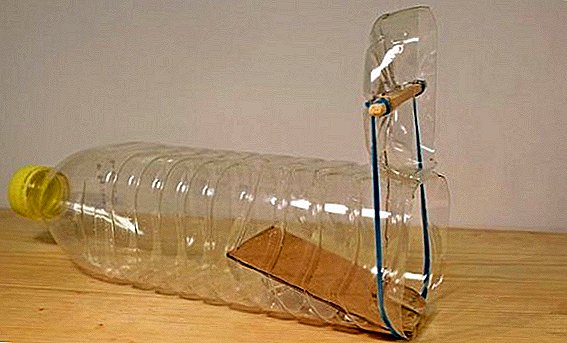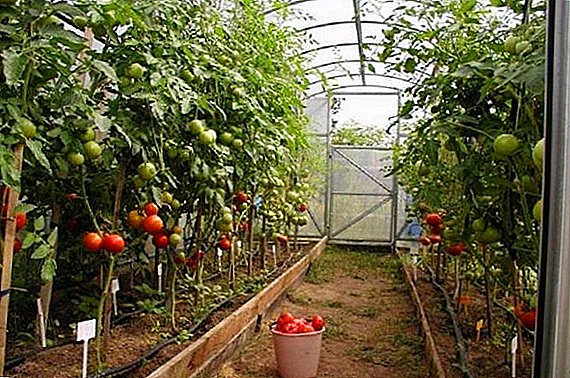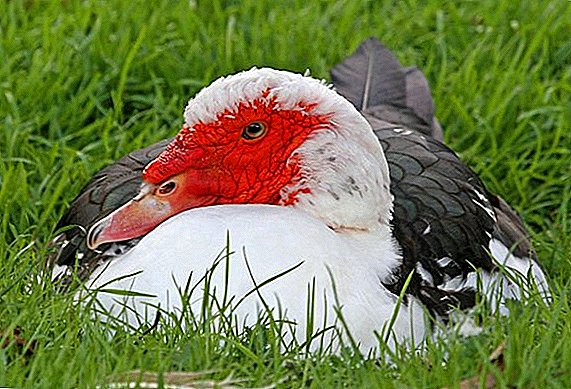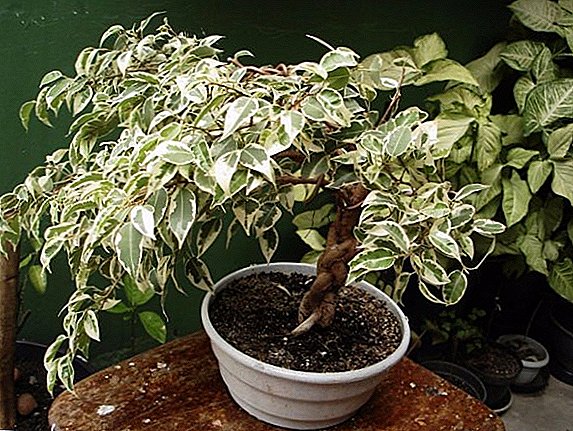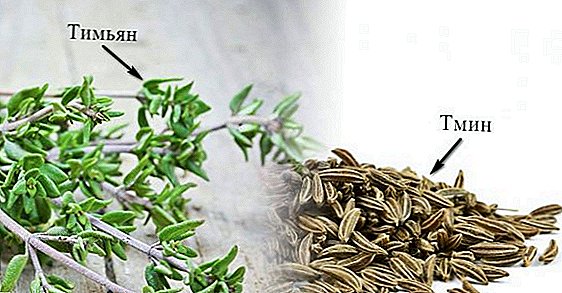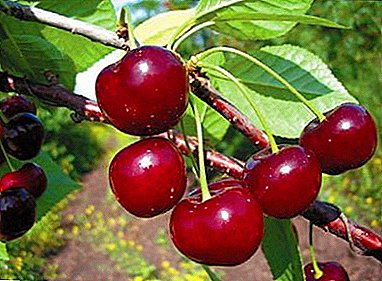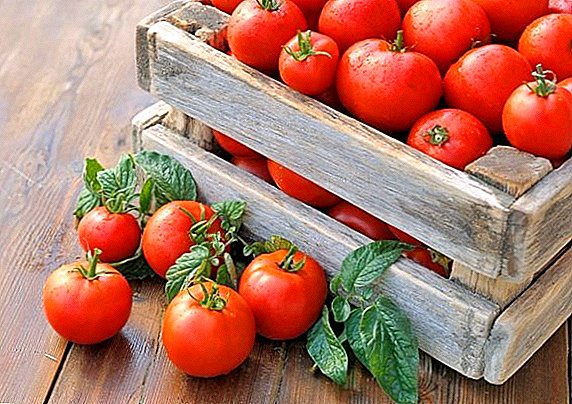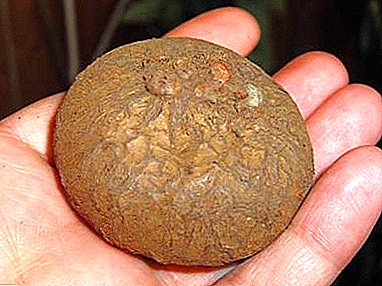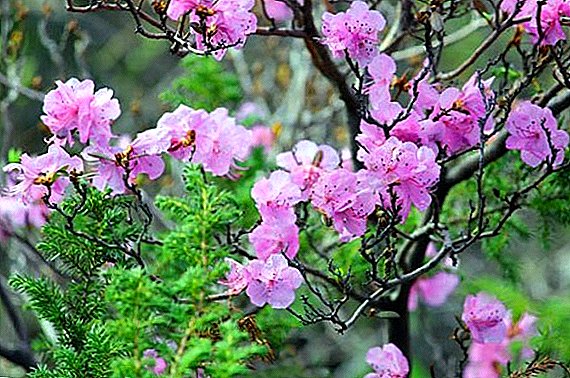 Those who are fond of gardening and breeding indoor plants, are always looking for new unusual plants in their collection. Ledebour's rhododendron can be such an interesting acquisition. A plant with an elegant name and no less elegant species, rhododendron is known for its unpretentiousness and unique early flowering. It is convenient to expel it in the winter, when other plants fall into sleep, or leave it in open ground - this shrub can withstand very low temperatures. Let's take a closer look at it - find out how to plant this flower, as it is called by the people and why it is so popular in ornamental gardening.
Those who are fond of gardening and breeding indoor plants, are always looking for new unusual plants in their collection. Ledebour's rhododendron can be such an interesting acquisition. A plant with an elegant name and no less elegant species, rhododendron is known for its unpretentiousness and unique early flowering. It is convenient to expel it in the winter, when other plants fall into sleep, or leave it in open ground - this shrub can withstand very low temperatures. Let's take a closer look at it - find out how to plant this flower, as it is called by the people and why it is so popular in ornamental gardening.
Botanical description
Rhododendron Ledebour (still known as wild rosemary and maral) is a semi-evergreen shrub native to Altai, which in nature grows only in the subalpine zone and is protected in protected areas. Originally from the Heather family, rhododendron grows to one and a half meters and has thin branches. Its name is composed of two Greek words “rodon” and “dendron” - “rose” and “tree”, respectively.

Young shoots are always of a lemon-green color, those that are older are reddish-brown with a brown tinge. The leaves on the shoots grow soft, bright olive color, curl up in tubules with strong frosts and open only in warm weather. They fall when the bush begins to release new branches. Rhododendron flowers - its main advantage. They are large, up to 5 cm long, pure purple, sometimes there is a pink tint. Rhododendron blooms twice - in spring and autumn. Gives fruit in the form of boxes.
Important! At the wild rosemary the flowering periods alternate - first, abundant flowering, then scanty. Thus the bush rests. To equalize flowering to the level of permanent lush, break off faded flowers immediately after withering. The bush will give all its strength to the growth and the formation of new flower buds, and not to maintain the old ones.
Choosing a landing site
Best of all rhododendron feels on stony acidic soils - this is how it grows in the wild. Choose a penumbra for the maral, a place protected by the branches of trees and other bushes without drafts. This species loves moisture and moderate coolness - ideal if there is a pond or a lake nearby. The larger the flowers gives the bush, the more light it will need.

The maral has a delicate root system - plant it under trees with roots that go deep so that the plants do not interfere with each other. Optimal trees-neighbors are pine, chestnut and garden trees. A transplant may be required if the planted bush begins to wilt.
Like rhododendron, the heather family includes heather ordinary, azalea, arbutus wild rosemary, strawberry tree, Erica.
The competent choice of saplings upon purchase
Rhododendron Ledebour - the most frost-resistant variety. You can choose it either in the nursery, or in the agrofirm, or at the exhibition. The nursery and agrofirm are more reliable - competent people work there to help you choose a healthy rhododendron Ledebour and advise on planting and caring for him. At exhibitions you can buy if you are already oriented in gardening. If you give in to the general excitement, you can choose a weak plant that does not live up to expectations, if it takes root at all.
Did you know? Eastern culture considers rhododendron a symbol of female seductiveness and carnal pleasures. Its unusual alluring smell is associated with sensuality and desire.
If you buy a two or three year old bush, be guided by the shoots and leaves. There should be a lot of shoots, and densely growing. On the leaves there can be no blisters, spots, stains - this is a sign of infection by parasites. Inspect the roots, they should be smooth, without cones and knots. Saplings are grown by cutting and from seeds. Cuttings expelled to a height of 20 cm, the seeds have time to germinate up to fifteen. This is the height for open ground; in greenhouses, rhododendron grows more readily, but then it gets worse, so choose a low seedling.

Stepwise landing process
In open ground rhododendron is planted at any time, except for flowering. Choose the most convenient month for you from March to October. The soil will be rich in peat, acidic, so dig a hole a little deeper than half a meter deep, 60 cm wide and fill it with peat and clay in a 4: 1 ratio. Ram in the pit soil mixture, dig a hole in it for planting shrubs. It is better not to plant the shrub with a ready lump of earth - first hold it in a tank with water until the root system stops letting air bubbles out. Transfer the shrub to the soil and pour it with the substrate until the entire root system is underground. Lightly tamp the soil, add more, right under the neck of the roots, and pour plenty of water on the landing site if the ground was dry.
We advise you to learn how to grow rhododendron in Siberia, the Moscow region and the Leningrad region
The root system of rhododendron is thin and sensitive. It would be better if you cover it from above with garden mulch - chopped branches and tree bark. Moss and needles are still suitable for this purpose. Pour a layer of mulch at least 5 cm. Examine the planted shrub, cut off some of the flowers and buds, so that all the sap of the plant is allowed not to bloom, but to root. If there is no windless place on the plot, and the bush is still loose, dig a stick next to it. When the bush takes root, you can dig it out.

Use in Ornamental Horticulture
Landscape and phytodesign use rhododendron for the average level of flower arrangements. Low-growing bushes are good for small gardens, for large gardens the maral is almost not pruned so that it grows. Groups of these bushes are planted along the paths, creating low purple alleys. Designers mix varieties with different flowering periods so that the garden will bloom from spring to autumn. In the center of the compositions high bushes are planted, closer to the edge - low ones to create a cascade effect.
Ledebour's rhododendron looks spectacular against the background of coniferous trees - no description will suffice. It is only necessary to see. For the lower level of ornamental take cereal and perennial grasses. Maral is planted separately from other elements of the garden - flower beds and fountains, so that they do not distract attention from each other. Popular landing next to the porch or terrace on the ground lawn. For alpine slides take only stunted varieties, but always planted in groups.
Important! Most often, rhododendron affects fungal diseases of nature. The worst ones are chlorosis and rust. To prevent the plant from dying, spray it with copper sulphate and add iron chelate to the water with which you water.
Care Tips
Ledum is unpretentious, the main thing for him is a well chosen place. Procedures for the care are carried out standard: watering, spraying, pruning dead shoots and leaves, loosening the soil and feeding as needed.

Watering
Water the rosemary need often and only soft water. You can collect rainwater, you can collect it ahead of time and stand with a handful of peat to increase acidity. The more abundant the watering, the better the bush will bloom next year. Do not flood the plant, make sure that the roots do not form puddles. The need for rhododendron irrigation is determined by the leaves - they wither when there is a shortage of moisture. In strong heat, the bush will be saved by frequent spraying from the spray gun and additional shadow.
Weeding
Weeds drown out the root system of wild rosemary by removing nutrients from the soil. There are cultivated herbs that fight weeds, but they are expensive, and it is not known how the bush will react to them. Therefore, the best solution would be manual weeding. If occasionally loosening the soil with sap, weeds that have not yet grown will collapse because it is much more difficult to destroy established weeds. The main thing - do not sap the root system of wild rosemary. A thick layer of mulch is a good preventative measure. Do not forget to water the mulch bush, as moisture passes more slowly through the bark and chips.

Top dressing
Rhododendrons need additional feeding all the time, even in the spring to which they were planted. The best is the liquid dressing of meat and bone meal or cow manure. Human waste and predatory domestic animals will not do - they only pollute the soil. Fertilize the bush during the growth of young shoots, then it needs additional nutrition most. Fill the manure or flour with soft water in the ratio of 1:15 and then bring it in.
Did you know? In 401 BC. er The Greek army retreated after the battle with the Persians across the Caucasus, the edge of rhododendrons. Burnt by a long way and an unsuccessful battle, travelers stumbled in the rocks colossal hives filled with honeycombs. They pounced on an unprecedented delicacy but, having gagged, fell victim to terrible hallucinations. The army was able to continue its journey only a few days later. The honey they ate turned out to be red honey collected from Pontic-grade rhododendrons, the pollen of which contains a special hallucinogenic toxin.
Use mineral fertilizers carefully, they affect the acid-base balance of the soil. Nitrogen, phosphorus and sulphate of potassium - the best solution for feeding. Another superphosphate will do. The smallest doses are taken: up to 40 g per 1 square meter. m plot before flowering and 20 g - after.

Pruning
For forming shoots pruning is rarely used - the bush keeps the correct shape itself. Pruning can control the height of growth and update the old bushes. Cut dead and dried shoots need in early spring, before the bush woke up. If the branches have grown thicker than 2 cm, the cut must be coated with varion so that the spring juices are not lost. Faded buds are cut off immediately, so that the sap of the bush leaves to form new buds.
Wintering
In the middle and southern bands, the maral tree hibernates well even without shelter - severe frosts can only harm the blossoming flowers. Gardeners in cold regions need to take care of their bushes. Usually, the maral is covered with sacking or other coarse cloth for the winter, previously laying a spruce and pine spruce branches for thermal insulation between the shoots of the bush. The fabric is pulled from above with ropes - not tight, but so that the bush keeps in a heap. Do not unwind maralnik until the spring, remove the burlap only with the onset of the first warm days when the snow begins to melt.

Breeding features
There are three ways of reproduction of rhododendron - cuttings, seeds and layering. Seed propagation is the most difficult and long-lasting. The bushes that end up grow slowly and grow stunted with improper care. Cutting - the method is not much easier, but still more correct: the bushes grown from cuttings grow full-fledged, both in size and in inflorescences.
Important! Seedlings of rhododendron need to grow from six months to a year, and they bloom in the sixth or eighth year after landing in the ground. It will be much easier and faster to buy a ready sapling or propagate the plant in another way.
Layering
The fastest and most reliable way to propagate rhododendron is to take a young, strong escape from it. The more shoots you take in the spring, the more new bushes you will get at the end of the season. First you need to notice the strong, flexible shoots and dig a groove near them with a depth of at least 15 cm. Then you need to bend these shoots and attach them in the middle to the ground. On top of the place of attachment you need to pour the soil mixed with peat, and next to drive a peg. This peg will serve as a support for the young shoots, which are folded vertically and attached to the support.

During both periods of flowering and between them it is necessary to water both the main bush and the place of attachment of the shoot to the ground. Water and peat will stimulate the emergence of the root system at the shoot and its rooting. In the fall, you will be able to separate the young shoots from the mother bush with a secateur and plant it in a new place. This method is good for its simplicity and a high percentage of rooting young shoots.
Cuttings
In order for the grafting to be successful, rhododendron will have to be looked after a lot. In early spring, you need to select strong branches, which began to be covered with solid bark. Then they need to be cut into cuttings, each 5-7 cm long, and a day to endure sections in the root growth stimulator. When the root system begins to form in the cuttings, they will have to be transferred to a box with a peat-sand mixture (3: 1 ratio) under a polyethylene cover. In this homemade greenhouse cuttings must root.
Did you know? British botanist George Forest for the discovery of new varieties of rhododendron has experienced incredible trials in the summer of 1905. By chance, he was at the very center of the conflict between Tibetan priests and British missionaries. At the risk of being killed, Forest wandered around the Himalayas for several weeks, losing people from the escort until one was left completely alone. He managed to come across a village with friendly locals, who carried him across the pass and showed the way. This expedition failed, but for all the subsequent years of its life, Forest outfitted about seven more trips and revealed to the world more than three hundred varieties of these amazing plants.
Evergreen maral is used to soil longer than deciduous - four and a half months, respectively. Next comes the rearing stage, where shoots are transplanted into separate boxes with peat and needles (2: 1 ratio). In them, the maral is experiencing winter, and at the beginning of the season it is planted directly in the soil with a box so that the root system is not damaged. There he gets used to new conditions, for the winter he is brought back to the premises, and in the third year he is transplanted into the open ground.

As you can see, Ledebour's rhododendron is a capricious plant. Though beautiful. His amazing ability to bloom twice a season pays for all the effort expended on it. Rhododendron looks great both on the Alpine hills, and near the cozy overgrown terrace. Despite his grace, he tolerates strong frosts and easily gives shoots for grafting and cuttings. Remember the rules of care for rhododendron and its features of reproduction. Having bought several young saplings in the nursery, you will be able to multiply them in your own plot for several years and make this luxurious bush a subject of your pride and joy.


